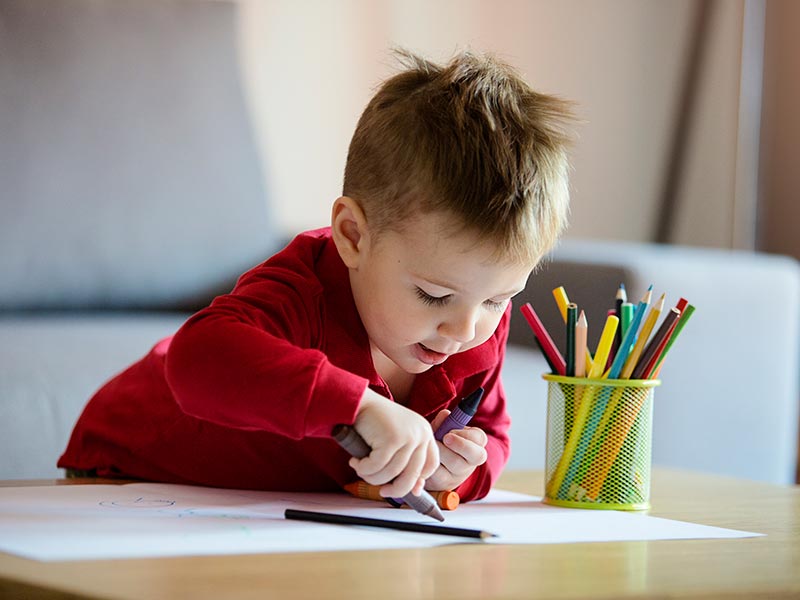




Attachment refers to the emotional connection between a child and their primary carer which starts at birth, develops quickly between 0 and 2 years and continues to develop throughout their lives. Babies will develop strong attachments to the people who meet their needs regularly during the first months of their lives.
These positive attachments are essential for good emotional development. A child will feel secure and confident when they have a secure attachment with their primary carer, which enables them to develop other social relationships.
Resilience is the ability to deal with stress, conflict, failure and challenges. Children with a sense of security and belonging and high levels of self-esteem and self-confidence are more resilient and are better at coping with life as they get older. Resilience helps children to deal with stressful situations, for example moving to a new school, dealing with bullying, grief, poverty or separation of parents.
Promoting resilience can help children, if they need to cope with new and challenging situations. As self-identity, self-esteem and self-confidence increase, their personal and social skills develop, and they become more independent.
Resilience, self-identity, self-esteem and sense of security and belonging help children value and feel positive about themselves. They will feel comfortable and will be able to experience a range of emotions without feeling overwhelmed.
The ability to form and maintain relationships is crucial for children as it supports their learning, growth, development and well-being. If babies' emotional needs are met through relationships where there is a strong attachment, they are more likely to develop resilience and more likely to:
Developing and maintaining relationships with their main carer supports children and leads to positive behaviour. Babies who develop strong attachments to their main carer are more likely to be well-behaved and have a positive view of themselves and others.
Children who have suffered abuse are likely to have insecure attachments with their primary carers as they have been left on their own without support at anxious times. Insecure attachments may also develop if parents are not consistent with their children, e.g. showing a lot of love one day, and behaving aggressively the next day. Signs of insecure attachment include:
In order to promote attachments between a young child and their primary carer, the following is needed:
| Secure attachment | Children with secure attachment are comfortable with others, can depend on them and value (and are comfortable with) intimacy. |
| Avoidant attachment | Children with avoidant attachment are doubtful of others. They find it harder to form relationships, they shy away from intimacy and have trust issues. |
| Anxious attachment | Children with anxious attachment like to develop close relationships with others but struggle with this because they fear rejection. |
| Insecure attachment | Children with insecure attachment avoid or ignore the caregiver and show little or no emotion when the caregiver leaves or returns. |
| Ambivalent attachment | Whilst the child can become very distressed when a parent or caregiver leaves, when reunited, the child does not display behaviour that suggests a strong attachment to the parent or caregiver. The child may or may not acknowledge or respond to the return of the parent or carer and can often seem to ‘watch from afar'. |
| Disorganised attachment | As the label suggests, the child’s attachment is unpredictable and can be inconsistent. The child may ignore or avoid the carer or resist their attempts to engage or offer comfort. The child may have experienced different behaviours from the carer in the past e.g. sometimes caring but on other occasions displays dismissive, aggressive or abusive behaviour. |
Mae ymlyniad yn cyfeirio at gysylltiad emosiynol plentyn a'i ofalwr sylfaenol sy'n dechrau ar adeg geni, yn datblygu'n gyflym rhwng 0 a 2 oed ac yn parhau i ddatblygu gydol oes. Bydd babanod yn datblygu ymlyniadau cryf at y bobl sy’n diwallu eu hanghenion yn rheolaidd yn ystod y misoedd cyntaf wedi genedigaeth.
Mae ymlyniadau cadarnhaol yn hanfodol ar gyfer datblygiad emosiynol da. Bydd plentyn yn teimlo'n ddiogel ac yn hyderus pan fydd ganddo ymlyniad diogel gyda’i brif ofalwr ac mae hyn yn ei alluogi i ddatblygu perthnasoedd cymdeithasol eraill.
Gwydnwch yw'r gallu i ddelio gyda straen, gwrthdaro, methiant a heriau. Mae plant sydd ag ymdeimlad o ddiogelwch a pherthyn ac sydd â lefelau uchel o hunan-barch a hunanhyder yn fwy gwydn ac yn gallu ymdopi â bywyd yn well wrth iddynt fynd yn hŷn.
Mae gwydnwch yn helpu plant i ddelio â sefyllfaoedd sy'n peri straen, er enghraifft symud i ysgol newydd, delio â bwlio, galar, tlodi neu rieni yn gwahanu. Wrth i hunaniaeth, hunan-barch a hunanhyder plant gynyddu byddant yn datblygu eu sgiliau personol a chymdeithasol, a dod yn fwy annibynnol.
Mae gwydnwch, hunaniaeth, hunan-barch ac ymdeimlad o ddiogelwch a pherthyn yn gymorth i blant werthfawrogi a theimlo’n bositif am eu hunain.
Mae'r gallu i ffurfio a chynnal perthnasoedd yn hanfodol i blant gan ei fod yn cefnogi eu dysgu, twf, datblygiad a'u lles. Os bydd anghenion emosiynol babanod yn cael eu cwrdd drwy berthnasoedd lle mae’r ymlyniad yn gadarn, byddant yn datblygu gwydnwch ac yn fwy tebygol o:
Mae meithrin a chynnal perthnasoedd gyda’u prif ofalwr yn gymorth i blant ac yn esgor ar ymddygiad cadarnhaol. Mae babanod sy'n datblygu ymlyniad cryf i'w prif ofalwr yn fwy tebygol o ymddwyn yn dda a bod â synnwyr cadarnhaol amdanynt eu hunain ac eraill.
Mae plant sydd wedi dioddef camdriniaeth yn debygol o fod ag ymlyniad ansicr â’i gofalwyr sylfaenol gan eu bod wedi cael eu gadael ar eu pennau eu hunain a heb gymorth yn ystod cyfnodau pryderus. Gall ymlyniadau ansicr hefyd ddatblygu os nad yw rhieni’n gyson â’u plant, e.e. dangos llawer o gariad un diwrnod, a bod yn ymosodol y diwrnod nesaf.
Arwyddion o ymlyniad ansicr:
Er mwyn hybu ymlyniadau rhwng plentyn ifanc a’i ofalwr sylfaenol mae angen:
| Ymlyniad sicr | Mae plant ag ymlyniad sicr yn gyfforddus gyda phobl eraill, yn gallu dibynnu arnynt ac yn gwerthfawrogi agosatrwydd (ac yn gyfforddus ag ef). |
| Ymlyniad osgoi | Mae gan blant sydd ag ymlyniad osgoi amheuon am bobl eraill. Maent yn ei chael hi'n anoddach ffurfio cydberthnasau, maent yn osgoi agosatrwydd ac mae ganddynt broblemau o ran ymddiriedaeth. |
| Ymlyniad pryderus | Mae plant ag ymlyniad pryderus yn hoffi meithrin cydberthnasau agos ag eraill ond maent yn ei chael hi'n anodd gwneud hyn am fod arnynt ofn cael eu gwrthod. |
| Ymlyniad ansicr | Mae plant ag ymlyniad ansicr yn osgoi neu'n anwybyddu'r rhoddwr gofal ac yn dangos fawr ddim emosiwn wrth iddo adael neu ddychwelyd. |
| Ymlyniad amwys | Er y gall y plentyn fynd yn ofidus iawn pan fydd rhiant neu ofalydd yn gadael, pan fydd yn dychwelyd, nid yw’n dangos ymddygiad sy'n awgrymu ymlyniad cryf â’r rhiant neu'r rhoddwr gofal. Efallai bydd y plentyn yn cydnabod dychweliad y rhiant neu'r gofalydd neu'n ymateb iddo, neu efallai na fydd yn gwneud hynny. Yn aml, gall ymddangos ei fod yn ‘gwylio o bell’. |
| Ymlyniad di-drefn | Fel y mae'r label yn awgrymu, ni ellir rhagweld lefel ymlyniad ymddygiad y plentyn a gall fod yn anghyson. Efallai y bydd y plentyn yn anwybyddu neu'n osgoi'r gofalydd, neu'n gwrthwynebu ei ymdrechion i ymgysylltu neu gynnig cysur. Mae'n bosibl bod y plentyn wedi profi ymddygiadau gwahanol gan y gofalydd yn y gorffennol, e.e. gofalgar weithiau ond, ar achlysuron eraill, yn dangos ymddygiad diystyriol, ymosodol neu ddifrïol. |

Practitioners need to work in a way which maintains and encourages bonding and secure attachments for babies/toddlers. In order to do this, they must use different approaches such as:
Feedback from others (other staff, parents/carers or the children themselves) is important for learning and development, as it helps practitioners to develop awareness of their strengths, as well as areas for improvement.
Constructive feedback also helps practitioners to develop their confidence and plan for their future development in order to ensure that they maintain and encourage bonding and secure attachments for babies/toddlers.
The practitioner may see, through feedback, that more time needs to be set aside for personal care arrangements. This will enable the practitioner to adapt their routines to support secure attachments for babies and toddlers in the setting.
Mae angen i ymarferwyr weithio mewn ffordd sy’n cynnal ac yn annog ymlyniadau sicr a gwydnwch i blant. Er mwyn gwneud hyn mae angen defnyddio gwahanol ddulliau megis:
Mae adborth gan eraill (staff eraill, rhieni/gofalwyr neu'r plant eu hunain) yn bwysig ar gyfer dysgu a datblygiad gan ei fod yn helpu ymarferwyr i ddatblygu ymwybyddiaeth o’u cryfderau, yn ogystal â meysydd lle mae angen gwelliannau.
Mae adborth adeiladol yn helpu ymarferwyr i ddatblygu eu hyder a chynllunio’u datblygiad yn y dyfodol er mwyn sicrhau eu bod yn cynnal ac annog bondio ac ymlyniadau sicr i blant.
Efallai, drwy adborth, bydd ymarferydd yn adnabod yr angen i roi mwy o amser i drefniadau gofal personol. Bydd hyn yn galluogi’r ymarferydd i addasu ei arferion er mwyn sicrhau ei fod yn cefnogi ymlyniadau sicr i fabanod a phlant bach yn y lleoliad.